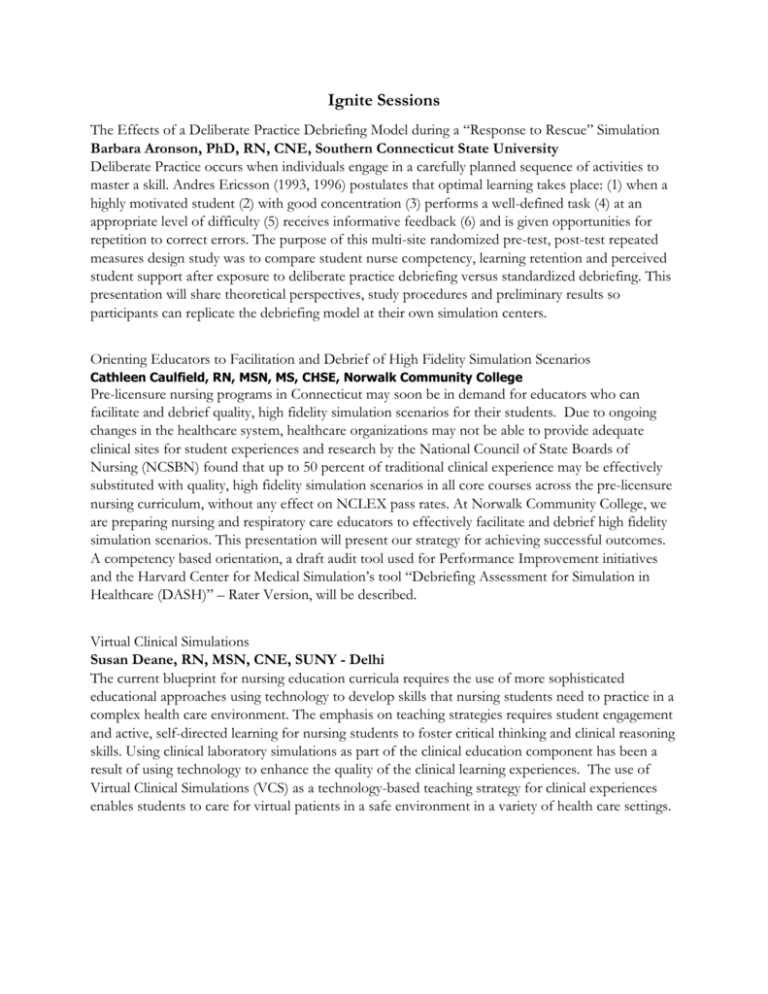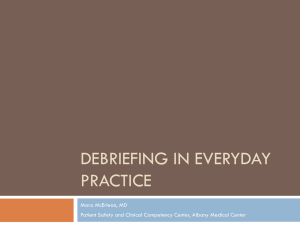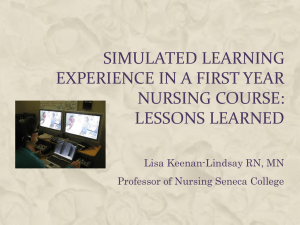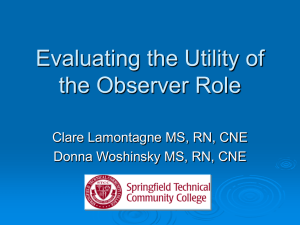Ignite Session Listings - Connecticut League for Nursing
advertisement

Ignite Sessions The Effects of a Deliberate Practice Debriefing Model during a “Response to Rescue” Simulation Barbara Aronson, PhD, RN, CNE, Southern Connecticut State University Deliberate Practice occurs when individuals engage in a carefully planned sequence of activities to master a skill. Andres Ericsson (1993, 1996) postulates that optimal learning takes place: (1) when a highly motivated student (2) with good concentration (3) performs a well-defined task (4) at an appropriate level of difficulty (5) receives informative feedback (6) and is given opportunities for repetition to correct errors. The purpose of this multi-site randomized pre-test, post-test repeated measures design study was to compare student nurse competency, learning retention and perceived student support after exposure to deliberate practice debriefing versus standardized debriefing. This presentation will share theoretical perspectives, study procedures and preliminary results so participants can replicate the debriefing model at their own simulation centers. Orienting Educators to Facilitation and Debrief of High Fidelity Simulation Scenarios Cathleen Caulfield, RN, MSN, MS, CHSE, Norwalk Community College Pre-licensure nursing programs in Connecticut may soon be in demand for educators who can facilitate and debrief quality, high fidelity simulation scenarios for their students. Due to ongoing changes in the healthcare system, healthcare organizations may not be able to provide adequate clinical sites for student experiences and research by the National Council of State Boards of Nursing (NCSBN) found that up to 50 percent of traditional clinical experience may be effectively substituted with quality, high fidelity simulation scenarios in all core courses across the pre-licensure nursing curriculum, without any effect on NCLEX pass rates. At Norwalk Community College, we are preparing nursing and respiratory care educators to effectively facilitate and debrief high fidelity simulation scenarios. This presentation will present our strategy for achieving successful outcomes. A competency based orientation, a draft audit tool used for Performance Improvement initiatives and the Harvard Center for Medical Simulation’s tool “Debriefing Assessment for Simulation in Healthcare (DASH)” – Rater Version, will be described. Virtual Clinical Simulations Susan Deane, RN, MSN, CNE, SUNY - Delhi The current blueprint for nursing education curricula requires the use of more sophisticated educational approaches using technology to develop skills that nursing students need to practice in a complex health care environment. The emphasis on teaching strategies requires student engagement and active, self-directed learning for nursing students to foster critical thinking and clinical reasoning skills. Using clinical laboratory simulations as part of the clinical education component has been a result of using technology to enhance the quality of the clinical learning experiences. The use of Virtual Clinical Simulations (VCS) as a technology-based teaching strategy for clinical experiences enables students to care for virtual patients in a safe environment in a variety of health care settings. Using Technology to organize and enhance your Simulation Program in Acute Care and Academia Desiree A. Díaz, PhD, RN-BC, CNE, CHSE The use of free online tools can enhance any type of simulation program. Technology such as OneNote can be used to have online access for simulation templates, schedules and manuals. This allows for smooth transitions between educators and those working with simulation. It has the ability to organize debriefing strategies in one location for quick reminders and updates to facilitate consistency amongst the team. A discussion and example will be shared for group participation and discussion. Using Clinical Simulation to Increase Staff Confidence Levels in Caring for Acute Stoke Patients Melissa Dibble RN, MSN, CAPA, MidState Medical Center The management of an acute ischemic stroke requires a rapid coordinated response to improve clinical outcomes. A simulation was developed for staff to demonstrate implementation of timesensitive protocols to manage a patient with stroke symptoms. We also sought to determine whether this simulation improved the learner’s confidence in identifying the stroke guidelines, symptom recognition, and documentation requirements. Staff was surveyed Pre and Post simulation to obtain confidence level data. The process and data collection methods will be briefly reviewed. What is CPR perfection and how can we achieve it? Michael LaPierre RN, MSN, Saint Mary’s Hospital, Quinnipiac University Statistics show that as little as 4% of cardiac arrest victims survive to discharge from a health care facility. This is a study that looks at quality of CPR and the role it plays, as a way to improve outcomes. The study assesses skill level among providers of CPR by demonstrating knowledge, both current and enhanced. Data is collected on the metrics during a three phase process. The best methods of improving skill level will be determined with the data obtained. Debriefing strategies, What to do and what not to do! Liza Nowicki RN, MSN, Hartford Hospital The CESI (Center for Education, Simulation and Innovation) at Hartford Hospital partnered with the medicine nursing department to establish a training program that would assist with ‘coaching-up’ staff to provide a better and more consistent customer experience (first phase: approx. 500 staff members). This training program utilized live-actor simulation scenarios to allow participants to practice the skills they had previously learned (online module) relating to daily patient encounters. The goal of this session would be to highlight the importance of effective debriefing strategies. We will review brief video clips of both motivating and discouraging debriefing attempts with nursing staff. Participants will understand the value of a self-reflective debriefing to truly change the culture for our patients. H.O.P.E (Helping Our Professionals Engage) Lillian A. Rafeld, MA, RN, CNE, Three Rivers Community College Simulation facilitates learning in educational and clinical settings. Debriefing starts, unites and accomplishes learning in multiple modalities. Why debrief? Participants learn and apply new knowledge but also engage in an atmosphere of self-awareness, collegiality and perceived support; increasing self-esteem, lowering performance anxiety and developing higher order critical thinking abilities. Multiple modalities include use of live participant patients, standardized patients, hi-tech mannequins, and virtual programs. Examples will be given which can be adapted to desired goals. Why debrief? There are “clinical reasons.”





